FivefamoussymbolsofChina中国著名的五个文化象征
- 格式:pptx
- 大小:6.43 MB
- 文档页数:11
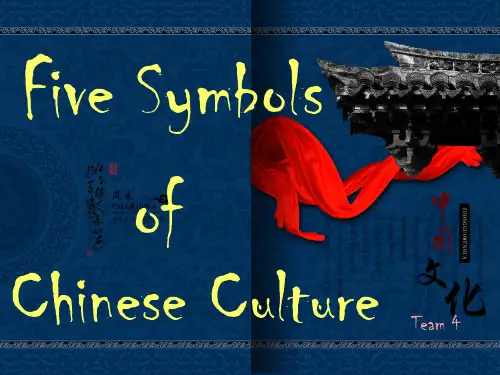
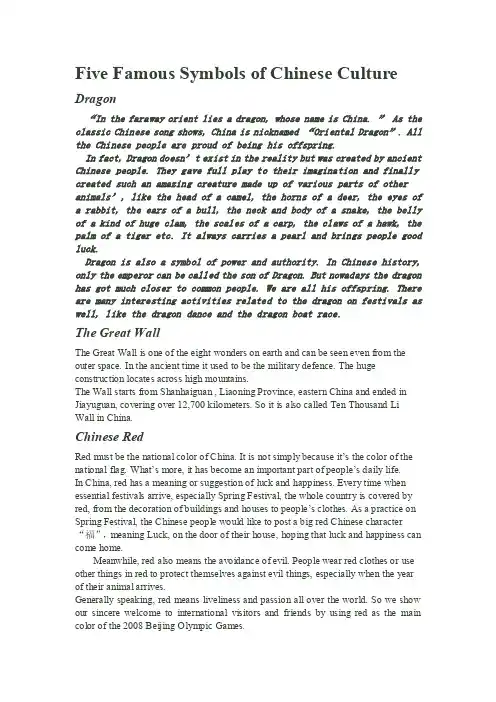
Five Famous Symbols of Chinese Culture Dragon“In the faraway orient lies a dragon, whose name is China. ” As the classic Chinese song shows, China is nicknamed “Oriental Dragon”. All the Chinese people are proud of being his offspring.In fact, Dragon doesn’t exist in the reality but was created by ancient Chinese people. They gave full play to their imagination and finally created such an amazing creature made up of various parts of other animals’, like the head of a camel, the horns of a deer, the eyes of a rabbit, the ears of a bull, the neck and body of a snake, the belly of a kind of huge clam, the scales of a carp, the claws of a hawk, the palm of a tiger etc. It always carries a pearl and brings people good luck.Dragon is also a symbol of power and authority. In Chinese history, only the emperor can be called the son of Dragon. But nowadays the dragon has got much closer to common people. We are all his offspring. There are many interesting activities related to the dragon on festivals as well, like the dragon dance and the dragon boat race.The Great WallThe Great Wall is one of the eight wonders on earth and can be seen even from the outer space. In the ancient time it used to be the military defence. The huge construction locates across high mountains.The Wall starts from Shanhaiguan , Liaoning Province, eastern China and ended in Jiayuguan, covering over 12,700 kilometers. So it is also called Ten Thousand Li Wall in China.Chinese RedRed must be the national color of China. It is not simply because it’s the color of the national flag. What’s more, it has become an important part of people’s daily life.In China, red has a meaning or suggestion of luck and happiness. Every time when essential festivals arrive, especially Spring Festival, the whole country is covered by red, from the decoration of buildings and houses to people’s clothes. As a practice on Spring Festival, the Chinese people would like to post a big red Chinese character “福”,meaning Luck, on the door of their house, hoping that luck and happiness can come home.Meanwhile, red also means the avoidance of evil. People wear red clothes or use other things in red to protect themselves against evil things, especially when the year of their animal arrives.Generally speaking, red means liveliness and passion all over the world. So we show our sincere welcome to international visitors and friends by using red as the main color of the 2008 Beijing Olympic Games.DumplingDumpling has been a kind of traditional Chinese food ever since the ancient time. It was invented by a famous doctor on Chinese Medicine, whose name was Zhang Zhongjing. However, his original purpose of that invention was to save the poor, protecting them against hunger, cold and illness.Nowadays Dumpling is much more popular both in and abroad. On the eve of Spring Festival, it is surely the main and essential dish of the dinner. It is enjoyed and loved by both the young and the old.ChopsticksChopsticks can never be missed when Chinese food is talked about, for they are the necessary tool for eating. The tool was invented about 3000 years ago, along with the beginning of civilization awareness. So chopsticks are also described by westerners as “Oriental Civilization”.Nowadays, chopsticks are not only a meal tool. According to a foreign research, chopsticks can help to develop the muscles and brains while eating by them. What a delicate exercise machine! Meanwhile, made of different materials and decorated with beautiful designs, chopsticks have already become kind of artwork. They are bought and sent as gifts frequently.。
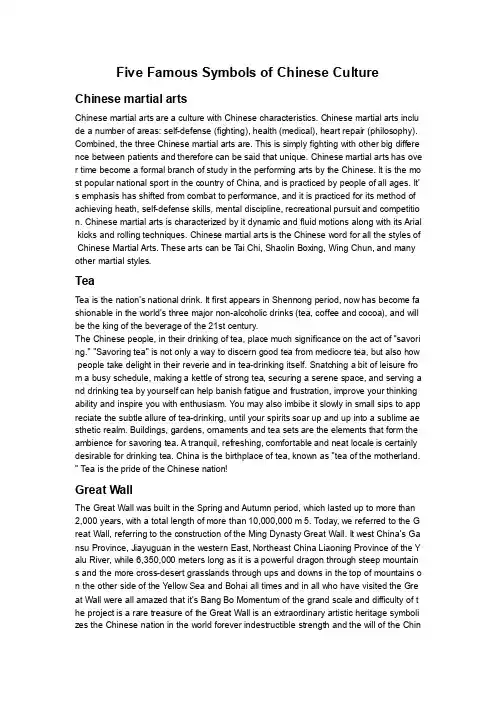
Five Famous Symbols of Chinese Culture Chinese martial artsChinese martial arts are a culture with Chinese characteristics. Chinese martial arts inclu de a number of areas: self-defense (fighting), health (medical), heart repair (philosophy). Combined, the three Chinese martial arts are. This is simply fighting with other big differe nce between patients and therefore can be said that unique. Chinese martial arts has ove r time become a formal branch of study in the performing arts by the Chinese. It is the mo st popular national sport in the country of China, and is practiced by people of all ages. It' s emphasis has shifted from combat to performance, and it is practiced for its method of achieving heath, self-defense skills, mental discipline, recreational pursuit and competitio n. Chinese martial arts is characterized by it dynamic and fluid motions along with its Arial kicks and rolling techniques. Chinese martial arts is the Chinese word for all the styles of Chinese Martial Arts. These arts can be T ai Chi, Shaolin Boxing, Wing Chun, and many other martial styles.TeaTea is the nation's national drink. It first appears in Shennong period, now has become fa shionable in the world's three major non-alcoholic drinks (tea, coffee and cocoa), and will be the king of the beverage of the 21st century.The Chinese people, in their drinking of tea, place much significance on the act of "savori ng." "Savoring tea" is not only a way to discern good tea from mediocre tea, but also how people take delight in their reverie and in tea-drinking itself. Snatching a bit of leisure fro m a busy schedule, making a kettle of strong tea, securing a serene space, and serving a nd drinking tea by yourself can help banish fatigue and frustration, improve your thinking ability and inspire you with enthusiasm. You may also imbibe it slowly in small sips to app reciate the subtle allure of tea-drinking, until your spirits soar up and up into a sublime ae sthetic realm. Buildings, gardens, ornaments and tea sets are the elements that form the ambience for savoring tea. A tranquil, refreshing, comfortable and neat locale is certainly desirable for drinking tea. China is the birthplace of tea, known as "tea of the motherland. " Tea is the pride of the Chinese nation!Great WallThe Great Wall was built in the Spring and Autumn period, which lasted up to more than 2,000 years, with a total length of more than 10,000,000 m 5. Today, we referred to the G reat Wall, referring to the construction of the Ming Dynasty Great Wall. It west China's Ga nsu Province, Jiayuguan in the western East, Northeast China Liaoning Province of the Y alu River, while 6,350,000 meters long as it is a powerful dragon through steep mountain s and the more cross-desert grasslands through ups and downs in the top of mountains o n the other side of the Yellow Sea and Bohai all times and in all who have visited the Gre at Wall were all amazed that it's Bang Bo Momentum of the grand scale and difficulty of t he project is a rare treasure of the Great Wall is an extraordinary artistic heritage symboli zes the Chinese nation in the world forever indestructible strength and the will of the Chinese nation is proud of is the pride of humanity as a whole.National Palace MuseumNational Palace Museum, also known as the Forbidden City, located in the center of Beiji ng, today, people called her the National Palace, which means the Imperial Palace in the past. East Palace 750 meters wide, 960 meters long from north to south, covering an are a of 720,000 square meters to reach for the world. From which twenty-four emperors of t he Ming and Qing Dynasties ruled China for some 500 years——from1420 to 1911. The Ming Emperor Yong Le, who usurped the throne from his nephew and made Beijing the c apital, ordered its construction, on which approximately 10,000 artists and a million work men toiled for 14 years from 1406 to 1420. At present, the Palace is an elaborate museu m that presents the largest and most complete ensemble of traditional architecture compl ex and more than 900,000 pieces of court treasures in all dynasties in China. Now the Fo rbidden City is no longer forbidding, but inviting one to visit to the Palace Museum will enr ich the visitors' knowledge of history, economy, politics, arts as well as architecture in anc ient China.The DragonThe dragon is commonly called Lóng in China. As a primitive totem of the Chinese peopl e it can date back to the Neolithic period. This sacred animal in the ancient Chinese lege nd, it is referred to as the divine mythical creature that brings with it ultimate abundance, prosperity and good fortune. Its benevolence signifies greatness, goodness and blessing; it symbolizes excellence, valiancy and boldness, heroism, perseverance, nobility and divi nity.In China, the dragon permeates through the great Chinese civilization because the peopl e have special worship to the dragon. In the old dynasties, the dragon was the emblem of the emperor and the imperial power. It was referred to something about the emperor, suc h as, the royal court was called dragon court, the imperial robe was called dragon robe, t he son of the emperor was call dragon son, the face of the emperor was called dragon fa ce, emperor’s head was called dragon head…very interesting. Some Chinese people eve n take the character of dragon (Lóng) as their family name; nearly all the Chinese parents hope their sons become dragons (means become a useful person) when they grow up a nd possess the energetic, decisive, optimistic, intelligent and ambitious like the dragon. Dragon has been comparable as the symbol of the Chinese nationality itself from time im memorial. Currently, the Chinese people around the world proudly proclaim themselves t he “Descendents of the Dragon”. But now when people mention the Chinese dragon it is usually associated with China and the Chinese culture.中国文化的五大标志中国武术中国武术是一种带有中国特色的文化。
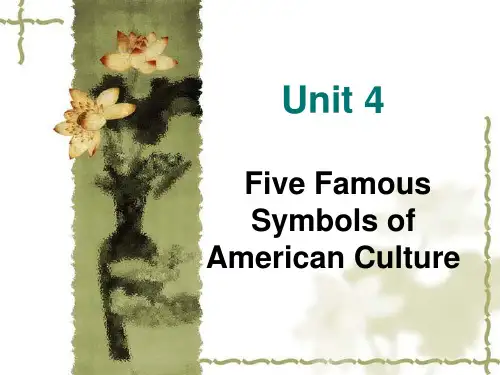
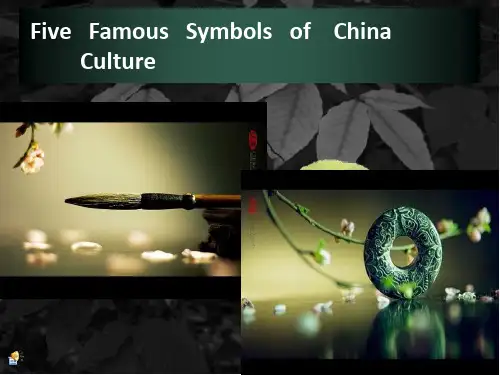
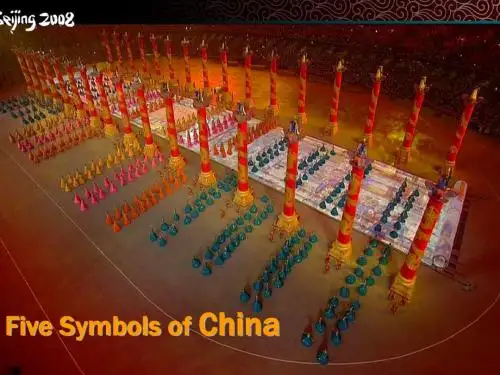
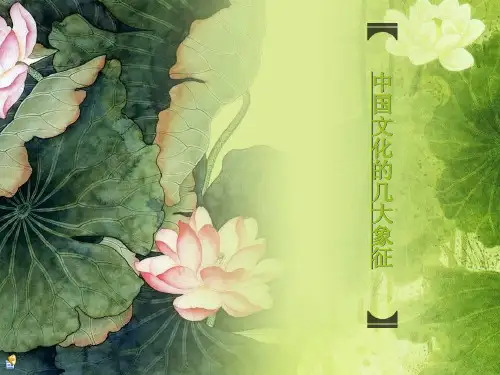
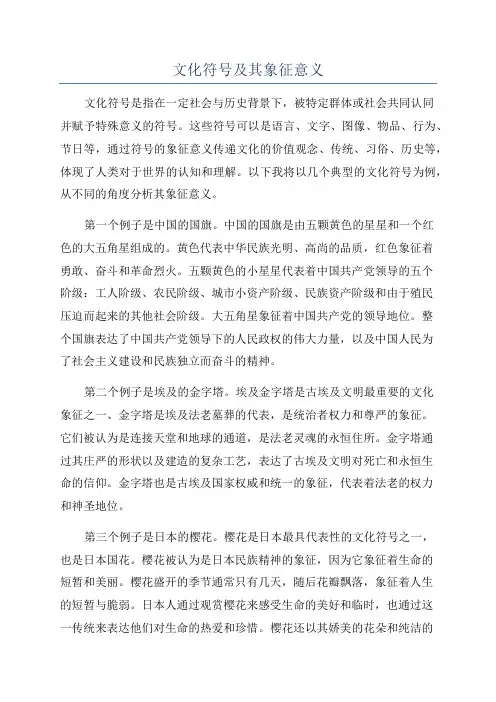
文化符号及其象征意义文化符号是指在一定社会与历史背景下,被特定群体或社会共同认同并赋予特殊意义的符号。
这些符号可以是语言、文字、图像、物品、行为、节日等,通过符号的象征意义传递文化的价值观念、传统、习俗、历史等,体现了人类对于世界的认知和理解。
以下我将以几个典型的文化符号为例,从不同的角度分析其象征意义。
第一个例子是中国的国旗。
中国的国旗是由五颗黄色的星星和一个红色的大五角星组成的。
黄色代表中华民族光明、高尚的品质,红色象征着勇敢、奋斗和革命烈火。
五颗黄色的小星星代表着中国共产党领导的五个阶级:工人阶级、农民阶级、城市小资产阶级、民族资产阶级和由于殖民压迫而起来的其他社会阶级。
大五角星象征着中国共产党的领导地位。
整个国旗表达了中国共产党领导下的人民政权的伟大力量,以及中国人民为了社会主义建设和民族独立而奋斗的精神。
第二个例子是埃及的金字塔。
埃及金字塔是古埃及文明最重要的文化象征之一、金字塔是埃及法老墓葬的代表,是统治者权力和尊严的象征。
它们被认为是连接天堂和地球的通道,是法老灵魂的永恒住所。
金字塔通过其庄严的形状以及建造的复杂工艺,表达了古埃及文明对死亡和永恒生命的信仰。
金字塔也是古埃及国家权威和统一的象征,代表着法老的权力和神圣地位。
第三个例子是日本的樱花。
樱花是日本最具代表性的文化符号之一,也是日本国花。
樱花被认为是日本民族精神的象征,因为它象征着生命的短暂和美丽。
樱花盛开的季节通常只有几天,随后花瓣飘落,象征着人生的短暂与脆弱。
日本人通过观赏樱花来感受生命的美好和临时,也通过这一传统来表达他们对生命的热爱和珍惜。
樱花还以其娇美的花朵和纯洁的形象,被用来象征着世代相传的传统文化和道德观念,体现出了日本文化的优雅和深沉。
文化符号作为人类文明的产物,具有多层次的意义和功能。
它们通过象征意义的传递,对于塑造和维护社会与群体的认同感、价值观念、传统和习俗起着重要作用。
同时,文化符号也在一定程度上反映了特定社会与历史背景下的思想观念和审美观念,以及人类对于世界的认知和理解。
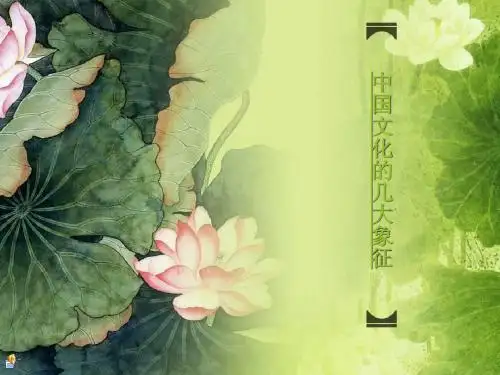
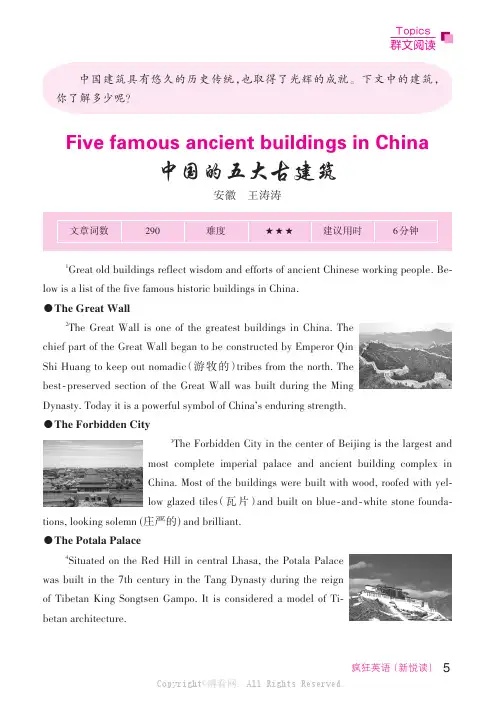
疯狂英语(新悦读)Five famous ancient buildings in China安徽王涛涛中国的五大古建筑中国建筑具有悠久的历史传统,也取得了光辉的成就。
下文中的建筑,你了解多少呢?1Great old buildings reflect wisdom and efforts of ancient Chinese working people.Be⁃low is a list of the five famous historic buildings in China.●The Great Wall 2The Great Wall is one of the greatest buildings in China.Thechief part of the Great Wall began to be constructed by Emperor Qin Shi Huang to keep out nomadic (游牧的)tribes from the north.The best⁃preserved section of the Great Wall was built during the MingDynasty.Today it is a powerful symbol of China s enduring strength.●The Forbidden City 3The Forbidden City in the center of Beijing is the largest andmost complete imperial palace and ancient building complex in China.Most of the buildings were built with wood,roofed with yel⁃low glazed tiles (瓦片)and built on blue⁃and⁃white stone founda⁃tions,looking solemn (庄严的)and brilliant.●The Potala Palace4Situated on the Red Hill in central Lhasa,the Potala Palace was built in the 7th century in the Tang Dynasty during the reignof Tibetan King Songtsen Gampo.It is considered a model of Ti⁃betanarchitecture.5Crazy English 2022.6Reading CheckⅠ.Choose the best answers according to the textDetail 1.What can we learn about the Great Wall from the second paragraph?A.It was firstly built during the Ming Dynasty.B.It showed China s powerful strength.C.It was the biggest ancient building in China.D.It took 11years to complete the construction.Detail 2.Which historic building will you choose if you want to visit an imperial palace in ancient China?A.The Great Wall.B.Zhaozhou Bridge.C.The Forbidden City.D.The Mausoleum of Emperor Qin Shi Huang.Detail 3.What can we learn about Zhaozhou Bridge from the last paragraph?A.It is a large wood⁃arched bridge.B.It was designed by architect Li Chun.C.It took about 40years to finish the project.D.It is located on the Xiao River inAnji.●The Mausoleum (陵墓)of Emperor Qin Shi Huang 5The Mausoleum of Emperor Qin Shi Huang is located about 35kilometers from Xi an City.It is the biggest imperial mausoleum in ancient China.Qin Shi Huang started building it as soon as he came into power.It was said that more than 700,000laborers were usedin this giant project and nearly 40years were used in building the mausoleum.●Zhaozhou Bridge 6Zhaozhou Bridge,also known as Anji Bridge,is a large stone⁃arched bridge designed by ancient architect Li Chun.The bridge is located on the Xiao River in Zhao County,Hebei Province.It is thelargest and oldest stone⁃arched bridge in the world.It took 11years to complete the bridge during the SuiDynasty.6疯狂英语(新悦读)Inference 4.Where can the text be found?A.In an art magazine.B.In a geography book.C.In a research paper.D.In a travel guidebook.Ⅱ.DiscussionWhat other great ancient buildings in China do you know?Please search for more in⁃formation about them and share it with your classmates.Language StudyⅠ.Discover the useful structure in the text It is/was said that...意为“据说……”;be used in 意为“被用于……”。
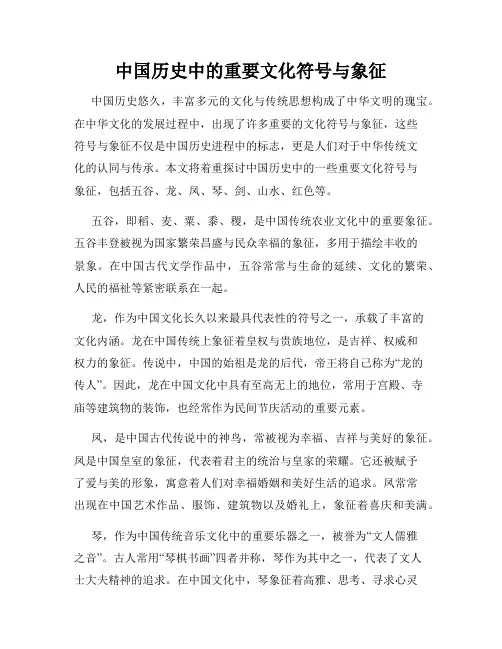
中国历史中的重要文化符号与象征中国历史悠久,丰富多元的文化与传统思想构成了中华文明的瑰宝。
在中华文化的发展过程中,出现了许多重要的文化符号与象征,这些符号与象征不仅是中国历史进程中的标志,更是人们对于中华传统文化的认同与传承。
本文将着重探讨中国历史中的一些重要文化符号与象征,包括五谷、龙、凤、琴、剑、山水、红色等。
五谷,即稻、麦、粟、黍、稷,是中国传统农业文化中的重要象征。
五谷丰登被视为国家繁荣昌盛与民众幸福的象征,多用于描绘丰收的景象。
在中国古代文学作品中,五谷常常与生命的延续、文化的繁荣、人民的福祉等紧密联系在一起。
龙,作为中国文化长久以来最具代表性的符号之一,承载了丰富的文化内涵。
龙在中国传统上象征着皇权与贵族地位,是吉祥、权威和权力的象征。
传说中,中国的始祖是龙的后代,帝王将自己称为“龙的传人”。
因此,龙在中国文化中具有至高无上的地位,常用于宫殿、寺庙等建筑物的装饰,也经常作为民间节庆活动的重要元素。
凤,是中国古代传说中的神鸟,常被视为幸福、吉祥与美好的象征。
凤是中国皇室的象征,代表着君主的统治与皇家的荣耀。
它还被赋予了爱与美的形象,寓意着人们对幸福婚姻和美好生活的追求。
凤常常出现在中国艺术作品、服饰、建筑物以及婚礼上,象征着喜庆和美满。
琴,作为中国传统音乐文化中的重要乐器之一,被誉为“文人儒雅之音”。
古人常用“琴棋书画”四者并称,琴作为其中之一,代表了文人士大夫精神的追求。
在中国文化中,琴象征着高雅、思考、寻求心灵的净化与舒缓。
琴的音乐旋律常被视为传递人文情怀和道德智慧的媒介。
剑,在中国历史中代表了英雄气概、武力与侠义精神。
剑作为一种兵器,具有荣耀与威严的象征。
中国古代的剑术被广泛传承与发展,剑客与剑术成为了许多文学、影视作品中的主题。
剑的形象不仅代表了武力的象征,更寄寓着人民对于正义和英勇的追求。
山水,作为中国传统绘画艺术中的重要主题,被尊为“中国画的灵魂”。
山水画以山川河流、湖泊和田园村落为题材,表现了自然景观与人文情怀的融合。
五吉祥文化
枸杞是中华民俗文化八大吉祥中植物之一。
古人云,所谓'吉者,福善之事;祥者,嘉庆之征'。
民俗文化中杞菊延年的吉祥图,画的就是菊花和枸杞。
2008年北京奥运会的标志使用了吉祥色中国红。
火红的枸杞是吉祥的象征,而在中国,红色象征着激情、喜庆、幸福,红色的文化是一种成功的文化,吉祥的文化,健康的文化。
火红的枸杞,火红的文化。
《诗经》中《小雅·南山有台》,作品以桑、杨、李和枸杞等树木比兴,颂扬"君子"德高望重,祝福他"万寿无疆",世代平安,子孙兴旺--"保艾尔后"。
《小雅·湛露》这首诗记叙的是贵族举行宗庙落成典礼时,一位宾客以枸杞、红枣和梧桐等树比兴,颂扬"君子"高贵的身份、显赫的地位、敦厚的美德和英武潇洒的气质。
在《诗经·湛露》篇中,诗人将沾满露水珠的晶莹透红的枸杞子与神圣的宗庙祭祀、喝成不醉不归的盛大宴饮联系在一起大唱赞歌,使人感到枸杞子与酒成了红红火火的激情象征,盛大宴饮的礼仪高潮,神圣祭祀的灵魂导引。
这说在西周时代,枸杞子就已走红人们的精神世界与物质世界,唱红了当时的社会生活。
在国内,好多地方过腊八节,将洗净的豆子,泡圆的红枣,枸杞煮烂的各式稻米谷粒放在一起,祈求吉利。
最具代表性的中国文化符号排行榜收藏打印发给朋友举报来源:unknown发布者: webmaster热度0票【共 0条评论】【我要评论】时间: 2011年1月10日20:27第一项:汉语 ( 汉字)汉语: Chinese language汉字: Chinese character表达汉字为英文中的“character ”,与特征、特性是一个词,拿来代表中国似乎最合适不过了。
富有特色的汉语与汉字,可是让不少外国友人头疼不已呢!第二项:孔子孔子: Confucius孔子思想: Confucianism现在,世界各地都有孔子学院,教授中国古代的孔孟之道,孔子代表着中国的礼教,在世界范围内的影响都是巨大的。
第三项:书法书法: calligraphy书法、笔迹: penmanship这个与汉字有异曲同工之妙,甚至含义更加深刻,与中国古代的文人气节密切相关,中国人普遍相信“字如其人”。
第四项:长城长城: the Great Wall“不到长城非好汉”这句话很多外国友人都知道了,到了中国来也得爬一爬长城。
英语中用“Great”来形容长城,即表现长城的“长”也表达出了它“伟大”的意思。
第五项:五星红旗五星红旗: the Five-Starred Red Flag (the national flag of the People's Republic of China)五星红旗代表着中国,世界人民都知道它是中国的国旗.... 。
第六项:中医中医: traditional Chinese medical science现在,外国人越来越重视中医理论,在他们看来,中医即神秘又神奇,常常有意想不到的功效,因此被津津乐道。
甚至还有科学家企图用现代科技手段测量中医里的“脉络”。
第七项:毛泽东毛泽东: Mao Zedong,the founder of the People's Republic of China毛泽东是中华人民共和国的第一任主席,更是中国社会主义政治的核心代表人物,甚至是很多外国友人的偶像,世界各地都有人收藏毛泽东语录与像章。